Heads, Not Tails
Simple tips for creating better fish portraits on the reefs at Wakatobi
Wakatobi is a favorite with underwater photographers. With dramatic reef scenes and literally thousands of species of marine life to discover, there’s never a shortage of photo ops. Some of the most prized images to capture are close-ups of fish, framed when they are looking back at you with seeming curiosity. But these are often also the most difficult scenes to create, as fish don’t always strike a cooperative pose, and may instead swim away or take refuge in the recesses of the reef. So how do you get them?
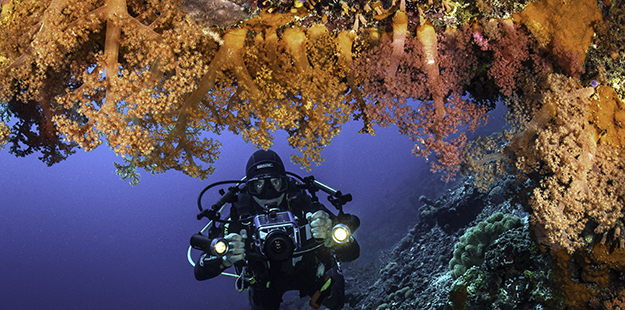
To a small fish, a diver with a camera and scuba equipment is not much different in size than a cruise ship. Photo by Wayne MacWilliams
Big threats
There you are, swimming along the reef with camera in hand. You spot a likely subject that’s just idling about, holding a position. Yet when you approach to capture the image, the star of the photo appears to flee in terror, and you say to yourself “why would it do that? I mean it no harm; it must be the camera!” We try to rationalize that the lens port resembles an open mouth of a large predator — triggering a flight reaction by the subject. The reality is that it’s not so much the camera, but what is right behind it. To a small fish, a diver with a camera and scuba equipment is not much different in size than a cruise ship. Additionally, body language will tell your subject a lot about your intentions. Fish, as well as other mobile creatures, survive by picking up on even the smallest hint of pursuit. While you can’t always avoid tipping your hand, there are things you can do to increase the odds of getting the shot.
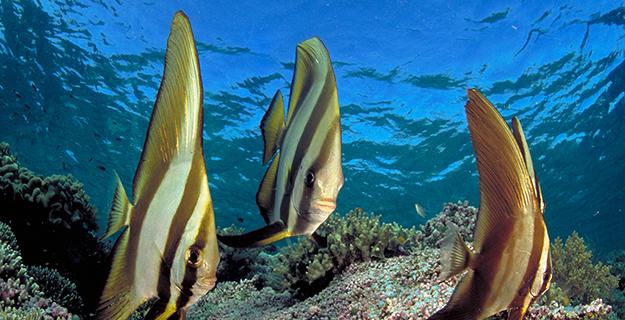
The nonchalant manner of fish like batfish can work to the photographer’s advantage as their curiosity provokes them to come closer to the camera. Photo by Werner Thiele
Swimmers
The first thing you need to determine before attempting to get close to a fish is whether they are a swimmer or a sitter. Swimmers are either active, moving hurriedly about the reef, picking and grazing as they go, or passive, just hanging about as if they have no place in particular. Sometimes, their seeming nonchalance can work to your advantage. For example, batfish seem to be not only immune to a diver’s presence, but may even be curious to the point of investigating these large, bubble-blowing intruders. This is more likely to happen if you hang back several feet and calmly behave as if you are not interested in the fish.
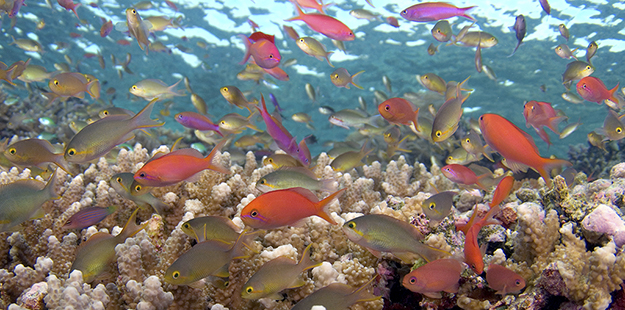
Getting a group shot of anthias can be easier by remaining still for several moments to allow them to re-emerge from their hiding place in the coral. Photo by Wakatobi Resort
Anthias are by far the most numerous small fish on the reef, and among the most colorful with shades of orange, purple, yellow and red represented by over four-dozen different species. Trying to capture one alone can be daunting, like singling out one bee from a swarm, whereas getting a group shot is easier. When you make your approach, the little fish will often take cover in the coral. But if you allow yourself to remain still for several moments they will re-emerge from hiding to feed once again in the current.
The odds of getting that great frontal or side portrait shot is not going to happen if you are chasing after the fish.
When it comes to more active subjects like clown triggerfish, for example, don’t expect them to hang around in one spot for very long. The odds of getting that great frontal or side portrait shot is not going to happen if you are chasing after the fish. Your most successful shot will come by first by watching where it is going and what it’s doing when it pauses on the reef. Once you have identified a pattern of behavior, you can anticipate where it will go next so you can be there when it passes by.

Territorial fish such as false clownfish can be downright aggressive when intruders come into their realm. Hence, it makes for some exceptional fish portraits. Photo by Tom Reynolds
Highly territorial fish can be a photographer’s best friends. They will defend their homes and their land fiercely against much larger fish, or intruders such as divers. Some examples of territorial fish include damselfish and anemonefish like false clownfish. When intruders come into their realm, they will swim at them with rapid, jerky swimming patterns and may even try to bite in an attempt to drive off the intruder. When the intruder is a camera, you can often accomplish a very good full-frontal picture of these fierce little critters.
Cuttlefish are fairly active creatures of the reef and they are also highly intelligent and curious. If you convey that you are not threatening, and are moving slowly and cautiously, their curiosity will often get the best of them and they’ll come closer to you.
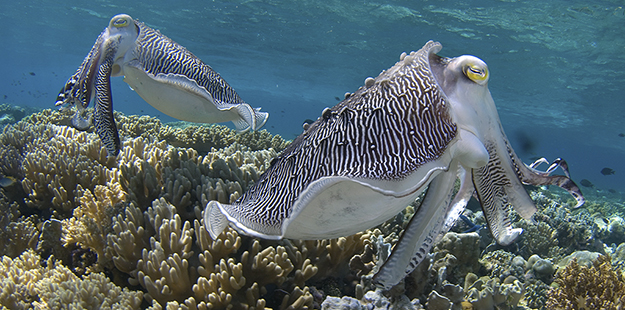
At Wakatobi, you never know when cuttlefish will reveal themselves. These two showed up on the House Reef strutting and posing for the camera. Photo by Mark Snyder
When this happens they can go through a variety of color patterns providing a great show, not to mention a series of photographs that can be mistaken for multiple cuttlefish rather than just one.
Each cleaning station brings a great opportunity for photographs. When a fish wants to get cleaned by a cleaner wrasse, they will stop and often turn darker to make light-colored parasites more visible. During cleaning, the fish will allow you to come closer. However, it is important to move slowly and still keep some distance, so the cleaners and their “client” are not disturbed.
Sitters
Yellownose Shrimpgobies are an example of small fishes that do not do much moving about. They stay in one spot, acting as sentries for the blind shrimp with which they share a burrow. Knowing this allows you time to prepare your camera settings. Once you’re ready to shoot, move in ever so slowly, and remain calm until you are close enough for that great shot.
Scorpionfish are true sitters, as they often have little reason to move. As their name suggests, scorpionfish can cause a painful sting, but this comes not from a dedicated stinger but from a series of sharp, venomous spines in their back. Like all members that belong to the family Scorpaenidae, they are also masters of camouflage; so before you can approach for the perfect shot, the challenge is to first find them.
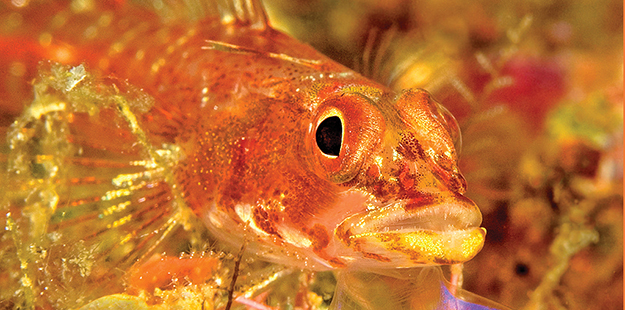
Fish such as blennies and gobies (seen here) rely on camouflage and can easily go unnoticed. But once found, they can make for a stunning fish portrait. Photo by Pasquale Pascullo
Many of the fish that rely on camouflage are also the most inactive, laying in wait for an unwary passerby to become the next meal. Some fish like blennies and gobies have a similar coloration to the color or bottom they tend to most associate with. They are likely to stay in one area and go unnoticed, and even when disturbed may dart only a short distance before resettling. Finding one of these stealthy species can be challenging, so the hunt is on.
Overall, the very best tool for an underwater photographer or even those who just like to watch fish comes from within: it’s patience. A good rule of thumb is to move slow, slower, slowest … and you will capture more of what you see in the process.
Ready to create your own fish portraits at Wakatobi? Start planning your photo safari by contacting our office at office@wakatobi.com or completing a quick trip inquiry at wakatobi.com. A guest experience representative will be in touch with you to answer any questions and help plan your visit.
Visit us on Facebook.


